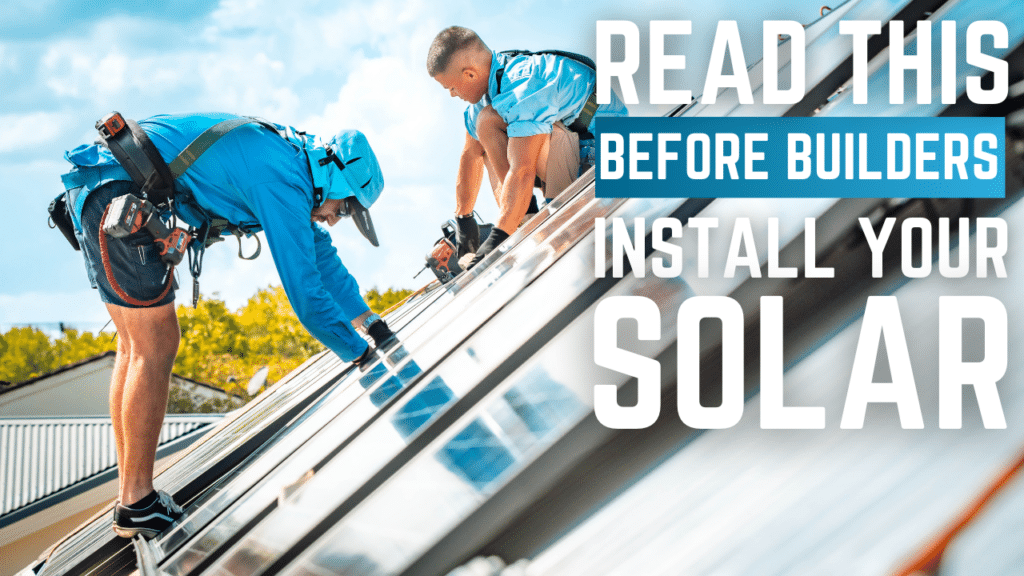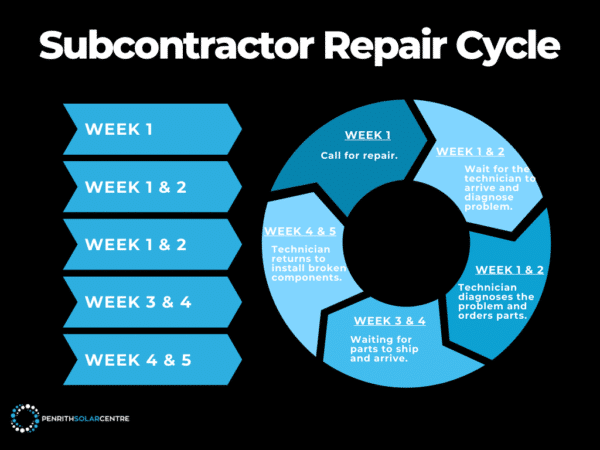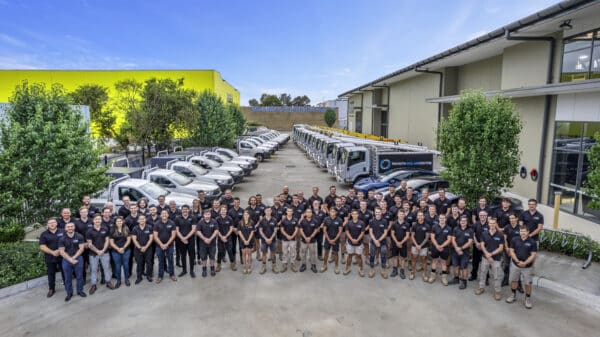
Who do you trust when shopping for a solar system? The internet is full of solar experts. Many of them honestly are experts – we’re not here to sling mud – but your needs and goals for your solar system and your energy usage are unique.
Every household has different needs and goals. We are all snowflakes, as individual as our fingerprints, and solar installations are the same.
It’s easy to discredit a competitor when what’s true for one customer is vastly different for another customer. Advice for one customer is wrong when applied to another home.
At Penrith Solar Centre, we understand that you are investing your hard-earned bread to chip away at those ever-increasing electricity bills. We want you informed about your choices, so you get a customised system to meet your needs and goals. From experts in the field.
In this article, you will learn:
- Should I Buy Solar from My Builder?
- How Big Should My Solar System Be?
- Where On My Roof Will the Solar Panels Go?
- Is There Room Inside and Beside the Main Switchboard?
- Is There Any Shading on My Roof?
- Is My New Home Single-phase or Three-phase?
- Are You Building My Home with Solar in Mind?
- Can I Talk to the Subcontractor You Want to Hire?
- Who Will Fulfil My Solar Product Warranties?
- How Much Will It Cost?
By the end of this article, you’ll have a series of questions to ask your builder who is insisting on being your one-stop solar installation service.
Should I Buy Solar from My Builder?
Okay, so your builder is offering to install a solar system that will meet the BASIX requirements for a new home. It sounds good to you. You want to pull the trigger and take advantage of everything solar has to offer.
But before you give your builder the green light, and in the interest of staving off some buyer’s remorse, you might want to consider asking some questions.
Does your builder install solar systems all day, every day?
Construction is a vaguely related field to solar – they hire electricians, we hire electricians. And because they’re often aware of their lack of knowledge, they’ll often hire a subcontractor to install the solar system. Does your builder know enough about solar to hire a reputable subcontractor?
There are so many wonderful solar installers out there who know so much about different types of solar system installations. Maybe ask one of them instead?
Pennies add up very quickly when you’re losing a percentage of your electricity because your solar system was not customised to your needs, which is how conversations with actual solar installation experts start.
Hiring a builder to install your solar system is like hiring a triathlete to teach you how to dance. Sure, they’re both incredible athletes, but neither really understands what the other must do to perform the amazing things they do.
If you’re interested in learning more about the differences between in-house installers like Penrith Solar Centre and working with subcontractors, you might want to check out the following article titled, In-house Installers vs. Subcontractors: Which is Better?
How Big Should My Solar System Be?
If your builder immediately tells you to install a 6.6kW solar system with a 5kW inverter, you should start shopping around for multiple quotes because they probably didn’t listen to your unique energy needs and goals.
Lesser solar sales companies like to pair 6.6kW of solar panels with a 5kW inverter because it is automatically pre-approved for connection to the grid according to the rules and regulations of your local DNSP.
The size of your solar system should be a direct reflection of your unique energy needs and goals. End stop. You build a system around what you need and what you want in the future.
It starts with a conversation where the solar installer listens rather than waiting for an opportunity to talk.
If you’re interested in learning more about why you might see so many 6.6kW systems with a 5kW inverter, you might want to check out, Why Do Companies Sell 6.6kW String Systems with 5kW Inverters?
Where On My Roof Will the Solar Panels Go?
If your builder is installing 6.6kW of solar on the northern-facing part of your roof without any regard for your energy usage in relation to where the sun is in the sky, then your system won’t be as efficient as it could be.
While we love a northern-facing roof, at Penrith Solar Centre, we prefer to include an east/west split for many homes to capture sunlight when you need it most; in the morning and afternoon (when you’re home).
If you’re interested in learning more about how your roof and the direction of your panels affect your system’s efficiency, payback period, and return on investment, you might want to check out the following article titled, Which Way Should Solar Panels Face in Australia?
We feel this topic is so crucial to a solar system’s efficiency that we expanded upon that article in another one you should definitely read titled, Can You Install Solar Panels on a South-facing Roof in Australia?
Is There Room Inside and Beside the Main Switchboard?
Regardless of the type of solar system you’re investing in, regardless of who is installing it, there should be free wall space near the main switchboard.
If your builder is recommending a string inverter system, you’ll need space for the inverter. It would be nice if that area is shaded too, because string inverters can get hot, especially in Australian summers.
You’ll probably want to add a solar battery to your system one day, so having extra room next to the string inverter would be lovely. However, if you’re thinking of installing a solar battery later, you need to discuss this with a solar installer. Some solar batteries don’t work with some solar systems.
It’s also important to note that solar technology is evolving very quickly. The components that work together today might not be compatible in ten years.
For example, the Tesla Powerwall 2 is an AC-coupled battery, and the Tesla Powerwall 3 is a DC-coupled battery. Powerwall 2 will work with almost every system, but the Powerwall 3 will only work with other DC-coupled technologies. Not every builder understands how to future-proof you solar.
If you’re interested in learning more about the ins and outs of retrofitting a battery at a later date, you might want to check out the following article titled, Adding a Battery to a Solar System.
Is There Any Shading on My Roof?
We don’t want to go on a rant here, but this is a topic we’re well and truly invested in here at Penrith Solar Centre: shading.
We install microinverter solar systems because of how effective they are at mitigating the problems a string inverter system inherently has by design – especially when it comes to shading.
Microinverter solar systems are more efficient in shaded conditions compared to a string inverter system or a hybrid inverter system like the Powerwall 3. Microinverters monitor power production at the panel level, making sure each panel is performing at its peak. If one panel is shaded or partially shaded, only that specific panel is affected.
When a string inverter system or a Powerwall 3 system has shading on one of the panels, the other panels in the string will drop in efficiency to match the underperforming panel. If half of the panel is obscured by shade, the other panels will output at 50% as well.
They work like Christmas lights: one goes out and the efficiency of the other panels drop to match it and reduce the output of the string.
If you’re interested in learning more about microinverter solar systems, you might want to check out the following article titled, Microinverters vs. String Inverters: An Honest Comparison.
Is My New Home Single-phase or Three-phase?
Because your home is being built, it will most likely be a three-phase site. There are a lot of variables that require solar experts to correctly install any kind of system on a three-phase home – whether it’s a string inverter system, a Powerwall 3 system, or a microinverter system.
You’ll want to make certain that your home is connected properly to the grid. How your home is connected will affect the options you have for solar on your roof depending on where you live. You might not be maximising your solar savings if your solar is not correctly installed.
It’s a somewhat technical conundrum, but we have articles that will help you understand how a three-phase connection to your home will save you money with a quality solar system.
Please check out the following articles on the topic titled, Single-Phase vs. Three-Phase: How Are They Different? and Do I Need to Upgrade to Three-Phase Electric Power for Solar?
Are You Building My Home with Solar in Mind?
Are the trusses in the right position? That makes a difference when installing a solar system on a Terracotta tile roof.
Are there skylights in the roof? They’re lovely in principle but they make it difficult to install solar panels.
Are you installing enough panels for your unique energy needs and goals? We keep repeating this because we feel it’s quite important.
There are multiple decisions that could be made around the design of your home, and most of them should be made according to what your builder recommends. However, when it comes to energy savings and the design of your system, you just might want to speak with someone who does that every day. And not just for one home.
We send out 10 installation trucks every morning to install premiere solar systems across the Sydney metro area. How many solar systems a day does your builder install?
If you’re interested in learning more about how something as simple as the type of roof you have will affect your solar system, you might want to check out the following article titled, How Does Your Roof Affect Your Installation?
Can I Talk to the Subcontractor You Want to Hire?
There are thousands of talented subcontractors installing solar nationwide. Many of them are great at their jobs (some aren’t, but that’s every profession). We’re not attacking any subcontractor at all, we’re just against hiring a subcontractor to collaborate at the end of the build.
A lot of builders don’t understand why it’s so important to get a solar installer to answer questions about system efficiency early in the build. Of course, as we mentioned earlier, if they installed solar systems full-time, they might know how important to your long-term savings some of these decisions are.
Ask to talk to their solar installation expert. See what they have to say. If they aren’t offering some insight into the things we mentioned previously in this article though, you might want to shop around. You’ll know when you find a quality installer.
If you’re interested in a few more questions to ask your subcontractor when they arrive, you might want to check out the following article titled, How Much Solar Do You Need?
Who Will Fulfil My Solar Product Warranties?
If your solar system was installed by a subcontractor, you’ll need to find out who is responsible for the warranties for the components of different equipment.
Often, there’s a disconnect between the subcontractor, the builder, and the sales company they purchased the solar components from. And often, none of them take responsibility for repairing the system when it underperforms or breaks.
Hypothetically, you could get caught in this cycle: the builder will blame the subcontractor for a faulty installation, the subcontractor will blame the manufacturer for faulty equipment, and, well, actually, no one blames the builder because why would they? They don’t have anything to do with the system or fulfilling the warranties for the components. They’re in the wind.

This can lead to a very frustrating round-robin of phone calls and delays in getting your system up and running again if it requires repairs of any kind.
If you had hired an in-house installer like Penrith Solar Centre, we would have fulfilled those warranties and been available for you to call should anything go wrong with any aspect of your system. A builder doesn’t have any skin in the game.
If you’re interested in learning a little more about the timeline of a faulty string solar system, you might want to check out the following article titled, String Inverters: Are They Worth It?
How Much Will It Cost?
Getting quotes for solar installations is a little like going to a doctor for a diagnosis: get a second opinion. The cost will vary wildly depending on the type of system you need which is based on your energy needs and goals.
A solar system with microinverters will cost about $1.30 – 2.00 per watt.
A string solar system with DC optimisers will cost about $1.10 – 1.80 per watt.
A string inverter solar system will cost about $0.60 – 1.00 per watt.
A Powerwall 3 system will cost about $0.80 per watt.
The math around the cost of a solar system is different from the pricing of supplies and labour for building a home. There’s the upfront cost of the system, but there’s also the value of that system over time. It’s eating into your energy bill each quarter. Within a few years, the payback period will conclude, and your electricity bill will be lower.
And don’t forget that the cost of electricity is rising each year. The value of your solar system will increase as rates climb because you will be self-generating electricity for years to come.
The cost of a new home is high. We understand this reality. What about your new home’s value?
If you’re spending over half a million dollars on a new build, do you really want to waste an additional $4,000 on a string system you’ll need to replace within three or four years because it just isn’t producing energy for you?
What is the cost of energy for you over the next 25 – 30 years? What is the value of not having to pay that hefty sum?
When you consider all of this, it’s probably a good idea to sit down at the kitchen table and do some math. For a little help with that math, you might want to check out the following article titled, What is the Payback Period for Solar Panels in Australia?
Spark My Words: Hire an In-house Solar Installer
Now you know all the questions you need to ask your builder before you push forward with purchasing solar from them. It’s just a conversation, but during that conversation, you should be able to understand if they’re going to cost you money in the long run or save you money in the long run. This is the most important thing to consider when investing in a solar system: how will your system save you money in ten years, not just now?
Shop around for quotes.
At Penrith Solar Centre, we understand that there are all kinds of pathways to a customer’s solar journey. Sometimes it’s with us, sometimes it isn’t. As we said in the introduction, we want you to be informed. Every solar system should be carefully tailored to your needs and goals. Ask questions and be heard.

If you’re interested in learning more about how different aspects of your build will affect your solar installation, you might want to check out the following article titled, How Long Will My Solar Install Take?









